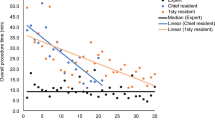Abstract
Purpose
To examine how much practice is essential to properly perform real-time sonoelastography (RTE) in the detection of PC.
Methods
RTE of the prostate was performed in 60 PC patients prior to radical prostatectomy (RP). All patients were examined by a novice and an expert observer in a blinded fashion. The novice’s results were validated with the results of the expert. Kappa indexes, sensitivities, specificities as well as the duration of the examination were assessed. Learning curves (LC) were obtained by assessment of 16 (LC A) and eight (LC B) prostate sectors. Cochrane–Armitage trend test, Chi2 test and t test for paired samples were used.
Results
For the 16-sector method (LC A), overall sensitivity and specificity were 58.2 and 77.7 % and, for the 8-sector method, 68.3 and 64.5 %, respectively. For LC A, sensitivity rose over the whole study period (p = 0.0055). As a result, no learning plateau was reached. In contrast, a learning plateau with no constant rise in sensitivity (p = 0.4667) was reached for LC B after 30 examined patients. The mean examination time for both observers was 7.9 min (±3.7).
Conclusions
When being trained by an expert examiner, skills in RTE of the prostate can be obtained quickly. Performed by a trained examiner, the examination itself is little time-consuming. Thus, RTE represents a user- and patient-friendly tool that can easily be integrated into the day-to-day practice of urologists.


Similar content being viewed by others
References
Siegel R, Ward E, Brawley O, Jemal A (2011) Cancer statistics, 2011: the impact of eliminating socioeconomic and racial disparities on premature cancer deaths. CA Cancer J Clin 61(4):212–236
Shepherd D, Keetch DW, Humphrey PA, Smith DS, Stahl D (1996) Repeat biopsy strategy in men with isolated prostatic intraepithelial neoplasia on prostate needle biopsy. J Urol 156:460–462
Loch T (2011) Prostate cancer diagnostics: innovative imaging in case of multiple negative biopsies. World J Urol (Epub Jul 9)
Salomon G, Köllerman J, Thederan I, Chun FK, Budäus L, Schlomm T, Isbarn H, Heinzer H, Huland H, Graefen M (2008) Evaluation of prostate cancer detection with ultrasound real-time elastography: a comparison with step section pathological analysis after radical prostatectomy. Eur Urol 56:1354–1362
Wells PN, Liang HD (2011) Medical ultrasound: imaging of soft tissue strain and elasticity. J R Soc Interface 8(64):1521–1549
Frauscher F, Gradl J, Pallwein L (2005) Prostate ultrasound—for urologists only? Cancer Imaging 5:S76–S82
Boursier J, Konate A, Guilluy M, Gorea G, Sawadogo A, Quemener E, Oberti F, Reaud S, Hubert-Fouchard I, Dib N, Calès P (2008) Learning curve and interobserver reproducibility evaluation of liver stiffness measurement by transient elastography. Eur J Gastroenterol Hepatol 20:693–701
Thurstone LL (1919) The learning curve equation. Psychol Rev 34:278–286
Pusic M, Pecaric M, Boutis K (2011) How much practice is enough? Using learning curves to assess the deliberate practice of radiograph interpretation. Acad Med 86(6):731–736
Singer JD, Willett JB (2003) Applied longitudinal data analysis: modeling change and event occurrence, 1st edn. Oxford University Press, New York
Ophir J, Céspedes I, Ponnekanti H, Yazdi Y, Li X (1991) Elastography: a quantitative method for imaging the elasticity of biological tissues. Ultrasound Imaging 13(2):111–134
Epstein RM (2007) Assessment in medical education. N Engl J Med 356(4):387–396
Wass V, Van der Vleuten C, Shatzer J, Jones R (2001) Assessment of clinical competence. Lancet 357(9260):945–949
Murphy DG, Bjartell A, Ficarra V, Graefen M, Haese A, Montironi R, Montorsi F, Moul JW, Novara G, Sauter G, Sulser T, van der Poel H (2010) Downsides of robot-assisted laparoscopic radical prostatectomy: limitations and complications. Eur Urol 57(5):735–746
Patel HR, Linares A, Joseph JV (2009) Robotic and laparoscopic surgery: cost and training. Surg Oncol 18(3):242–246
Koziol LF, Budding DE, Chidekel D (2010) Adaptation, expertise, and giftedness: towards an understanding of cortical, subcortical, and cerebellar network contributions. Cerebellum 9(4):499–529
Cicero S, Dezerega V, Andrade E, Scheier M, Nicolaides KH (2003) Learning curve for sonographic examination of the fetal nasal bone at 11–14 weeks. Ultrasound Obstet Gynecol 22(2):135–137
Brock M, von Bodman C, Sommerer F, Löppenberg B, Klein T, Deix T, Palisaar JR, Noldus J, Eggert T (2011) Comparison of real-time elastography with gray-scale ultrasonography for the detection of organ-confined prostate cancer and extra-capsular extension: a prospective analysis using whole mount sections after radical prostatectomy. BJU Int 108:E217–E222
Conflict of interest
None.
Author information
Authors and Affiliations
Corresponding author
Rights and permissions
About this article
Cite this article
Heinzelbecker, J., Weiss, C. & Pelzer, A.E. A learning curve assessment of real-time sonoelastography of the prostate. World J Urol 32, 317–322 (2014). https://doi.org/10.1007/s00345-012-0897-y
Received:
Accepted:
Published:
Issue Date:
DOI: https://doi.org/10.1007/s00345-012-0897-y




